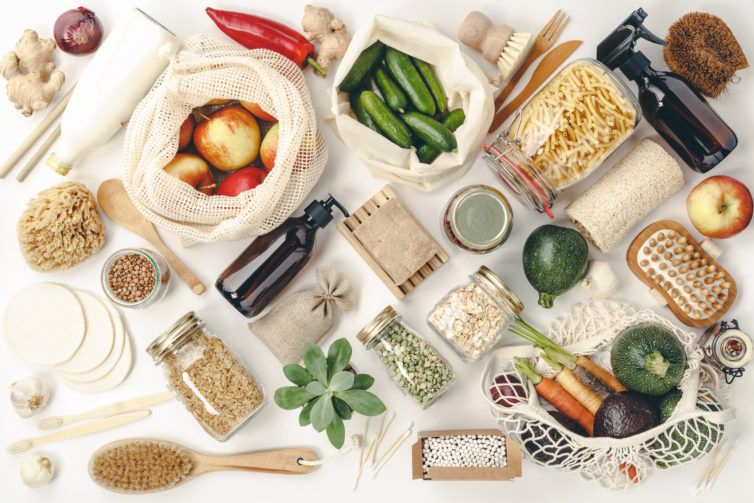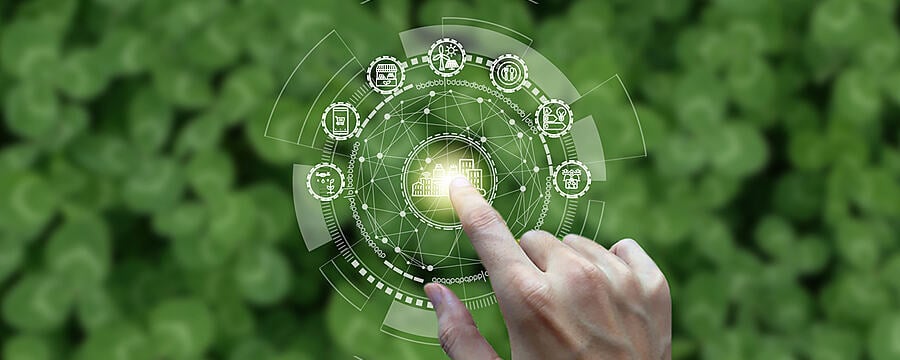Industrial Policy Strategy : To create a Sustainable Circular Economy and Bio-economy

You have learned before that the most common definition of Circular Economy builds on the 3R framework: reduce, reuse and recycle. We also learn more about the Circular Economy and Bio-economy as a policy strategy, as well as about the similarities between these two concepts.
EU industrial policy strategy
Especially now with the new European Green Deal, the European Union is fostering a Circular Economy Action Plan and an adjoining EU industrial policy strategy. Both are linked through the idea of industrial production systems being ‘fed’ with re-used, repaired, or upgraded products, or with recycled materials. The action plan presents a future-oriented agenda to develop Europe to a cleaner and more competitive stage, in co-development with economic stakeholders, citizens, consumers, and civil society organisations.
The action plan introduces a set of interrelated initiatives to enable a strong and consistent policy framework that will make sustainable products and services a norm, and that aims to convert consumption patterns toward producing no waste in the first place. This policy framework covers sustainable product design, empowering consumers and public buyers, and circularity in production processes. We are going now to explore this framework in more detail.
The EU sustainable product policy framework
In the new Circular Economy Action Plan, the European Commission highlights that one of the most significant actions to support the circular economy is sustainable product design. Up to 80% of the environmental effects of products are set at the design phase. The linear economic system, consisting of “take-make-use-dispose” phases, does not offer producers adequate incentives to manufacture more circular products. EU initiatives and legislation are already addressing to some extent sustainability aspects of products, either on an obligatory, or an optional basis. For example, the Ecodesign Directive (2009/125/EC) regulates energy efficacy and circularity features of products that are energy-related. However, there is no holistic set of requirements to make sure that all products in the EU market are increasingly becoming more sustainable and that would stand the test of circularity.
In order to ensure that products are adjusted for a climate-neutral, resource-efficient, and Circular Economy, the European Commission plans a legislative initiative for sustainable products. The aim of this legislative initiative is to extend the Ecodesign Directive beyond energy-related products, by increasing the scope of the Ecodesign Framework to include the widest possible range of products. In conjunction with the legislative initiative, the European Commission considers the widespread adoption of sustainability principles and other suitable ways to enhance product durability, reusability, upgradability, reparability, further product hazard levels disclosure, and the rising energy and resource efficiency of products. Other policy aspects include enhancing the ratio of recycled materials in products, and support remanufacturing and high-quality recycling. This legislative initiative will be advanced in a way to enhance the consistency with instruments that regulate products in several phases of their life cycle. The European Commission’s intention is that the product sustainability principles will guide broader policy and legislative developments in the future.
The EU’s sustainable product policy framework includes two more strategies. The first is to empower consumers and public buyers. Consumers’ participation in advancing the Circular Economy requires, amongst others, that there is reliable and relevant information on products, for instance about their lifetime, as well as on the accessibility of repair services and spare parts. For this purpose, the European Commission plans to propose a revision to European consumer legislation. The buying power of public authorities represents 14% of EU gross domestic product, and it can act as a driver of the demand for sustainable products. Therefore, the European Commission plans to propose minimum mandatory green public procurement (GPP) criteria and targets in sectoral legislation.
The second strategy is to increase circularity in production processes. The European Commission aims to make greater circularity possible in the industry, for instance by promoting the sustainable and circular bio-based sector following the actions in the Bioeconomy Strategy Action Plan, which includes mobilising stakeholders in the development and deployment of sustainable bio-based solutions, analyzing enablers, and barriers for the deployment of bio-based innovations, and developing bio-based, recyclable and marine biodegradable substitutes to fossil-based materials. The actions also include supporting the use of digital technologies to track, trace and map the use of resources in production processes.
The sustainable product framework that we explored above, requires holistic and coordinated actions to solve the sustainability challenges related to the production in value chains. Next, we will get to know some of the actions addressing circularity in the food value chain. In particular, we will look more closely at the EU food policy strategies.
Food
In Europe, achieving a Circular Economy can substantially decrease the adverse environmental effects of resource extraction and use, as well as support to restore biodiversity and natural capital. Biological resources are important to the EU economy and their position will be even more important in the future. Therefore the European Commission aims to ensure the sustainability of renewable bio-based materials, for example with the actions following the Bioeconomy Strategy and Action Plan.
The food value chain is facing remarkable resource and environmental pressures. Approximately 20% of the food produced is lost or wasted in the EU. Consequently, as part of the upcoming Farm-to-Fork Strategy, the European Commission targets a 50% reduction of food waste at the retail and consumer level by 2030. This attempt will have thorough implications for the organisation of the food value chain. Another feature of these ambitions is that both the action plans for Circular Economy and bio-economy are coherent in urging to prioritize biomass use rather than energy.
Yet, what is the bio-economy as opposed to the Circular Economy in the food context? Let’s explore their features in more detail!
Agri-food Circular Economy and bio-economy
Bioeconomy refers to an economy in which from nature derived renewable materials are utilized to produce food, energy, nutrients, products, and services. Bioeconomy advances the transition towards using renewable resources instead of nonrenewable materials. Furthermore, bio-economy is a strategy that is helping society to fight against current challenges, such as climate change and increasing competition over natural resources. As shown in the figure, the biomass flow starts on the left side with raw materials coming from agriculture and forestry and then continues via biomass, processing to food and feed, bioenergy and biofuels, chemicals and materials, and finally to bio-based products. The boxes show the specific attributes of the bio-economy along the value chain, which include, for example, the new developments in agriculture and forestry, organic recycling, and new processing pathways with lower toxicities.
 Concept of bio-economy (Click to expand)
Concept of bio-economy (Click to expand)
Source: Carus and Dammer, 2018
Bioeconomy and Circular Economy have a variety of similarities. For instance, they share the aim of saving natural resources and utilizing materials efficiently and sustainably. The aim of the Circular Economy is to improve the efficacy of utilisation of resources and recovery of waste materials, thus reducing emissions during production and extraction processes, such as greenhouse gas emissions from the use of fossil energy sources. In turn, regardless of sharing similar targets, the concept of bioeconomy has a focus on approaches to replace fossil carbon by renewable biomass derived from agriculture, forestry and marine environments.
Thus, bio-economy aligns with Circular Economy principles, but it focuses on bio-based approaches compared to other manufacturing sectors. In the bio-economy, much can be gained from raising circularity by merging the big amounts of organic processes and waste from agriculture, forestry, fishery, food and feed, and organic waste in the Circular Economy. The bio-economy requires new procedures based on knowledge, for example, biotechnology, algae for food, and new applications. Biomass waste stemming from agriculture, forestry, fishery, aquaculture, food, feed, and organic processes can be used for many applications, such as feed for aquaculture. Biodegradable products can also be used again in organic and nutrient value chains. Adding innovative additives from oleo-chemicals can be used to get other materials to become more recyclable. Innovative additives can come e.g. from vegetable and animal oils. Gathering and recycling bioplastics are also economically possible and competitive if the necessary amount of novel bio-based polymers can be reached.
Wrap Up
We examined the EU’s Circular Economy Action Plan and its product policy framework, as well as looked in this context at the food value chain, which is one of the key product chains in EU product policy strategy. We have also looked at the EU Circular Economy Action Plan in comparison to the Bioeconomy Strategy, both being based on two concepts with commonalities, but also substantial differences. Thus, we explored industrial policies facilitating the transition towards a Circular Economy at the EU level. However, it is obvious that Europe will not achieve full transitioning on its own. The EU will keep on moving towards a Circular Economy at the global level and exploit its authority, proficiency, and financial resources to achieve the United Nations 2030 Sustainable Development Goals, which we will deal with in the next step.
Share this
Circular Business Models for Sustainable Urban Food Systems

Circular Business Models for Sustainable Urban Food Systems


Reach your personal and professional goals
Unlock access to hundreds of expert online courses and degrees from top universities and educators to gain accredited qualifications and professional CV-building certificates.
Join over 18 million learners to launch, switch or build upon your career, all at your own pace, across a wide range of topic areas.
Register to receive updates
-
Create an account to receive our newsletter, course recommendations and promotions.
Register for free







